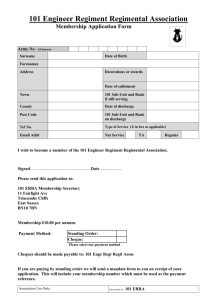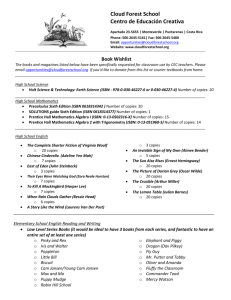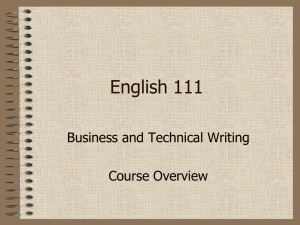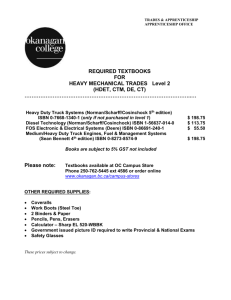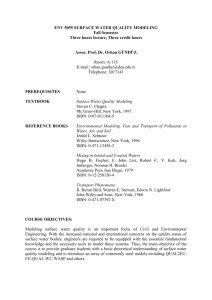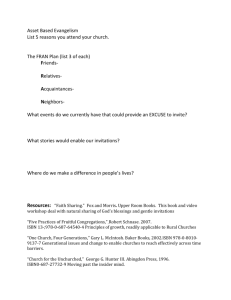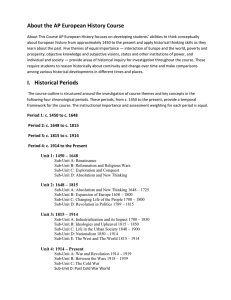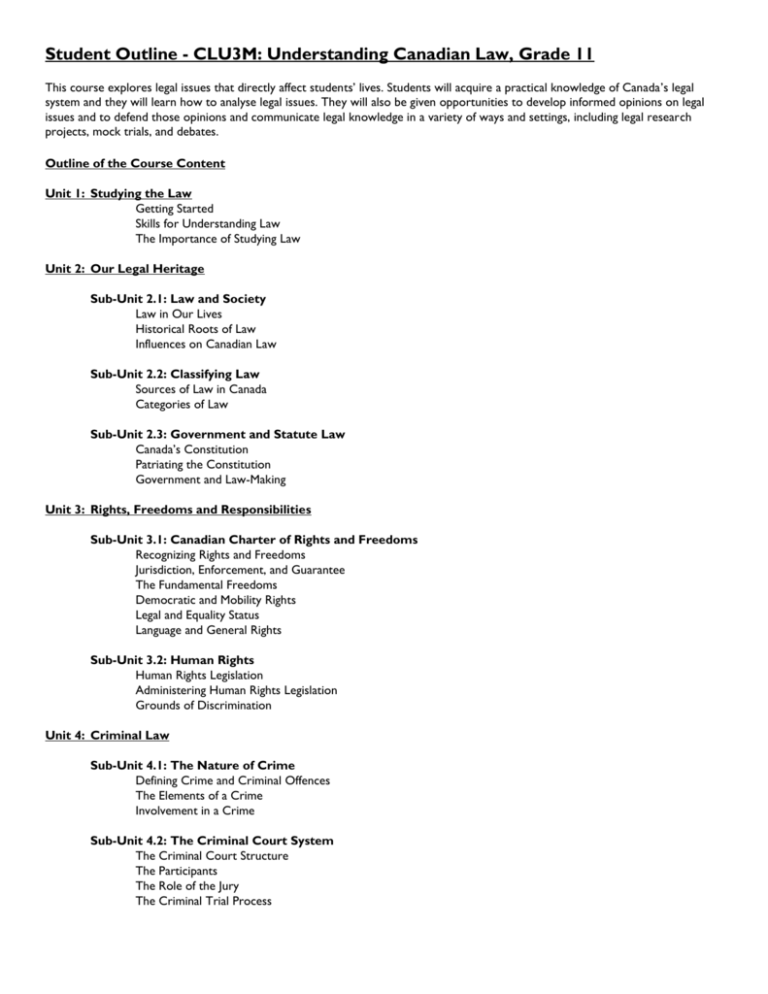
Student Outline - CLU3M: Understanding Canadian Law, Grade 11
This course explores legal issues that directly affect students’ lives. Students will acquire a practical knowledge of Canada’s legal
system and they will learn how to analyse legal issues. They will also be given opportunities to develop informed opinions on legal
issues and to defend those opinions and communicate legal knowledge in a variety of ways and settings, including legal research
projects, mock trials, and debates.
Outline of the Course Content
Unit 1: Studying the Law
Getting Started
Skills for Understanding Law
The Importance of Studying Law
Unit 2: Our Legal Heritage
Sub-Unit 2.1: Law and Society
Law in Our Lives
Historical Roots of Law
Influences on Canadian Law
Sub-Unit 2.2: Classifying Law
Sources of Law in Canada
Categories of Law
Sub-Unit 2.3: Government and Statute Law
Canada’s Constitution
Patriating the Constitution
Government and Law-Making
Unit 3: Rights, Freedoms and Responsibilities
Sub-Unit 3.1: Canadian Charter of Rights and Freedoms
Recognizing Rights and Freedoms
Jurisdiction, Enforcement, and Guarantee
The Fundamental Freedoms
Democratic and Mobility Rights
Legal and Equality Status
Language and General Rights
Sub-Unit 3.2: Human Rights
Human Rights Legislation
Administering Human Rights Legislation
Grounds of Discrimination
Unit 4: Criminal Law
Sub-Unit 4.1: The Nature of Crime
Defining Crime and Criminal Offences
The Elements of a Crime
Involvement in a Crime
Sub-Unit 4.2: The Criminal Court System
The Criminal Court Structure
The Participants
The Role of the Jury
The Criminal Trial Process
Sub-Unit 4.3: Investigation and Arrest
Levels of Policing in Canada
Starting a Police Investigation
Identifying and Collecting Physical Evidence
Arrest and Detention
Pre-Trial Release
Sub-Unit 4.4: Criminal Offences
Levels of Offences
Offences Against the Person
Offences Against Property
Other Criminal Code Offences
Drug Offences
Sub-Unit 4.5: Defences For the Accused
Mental States
Justifications
Other Defences
Sub-Unit 4.6: Sentencing and the Correctional System
Goals of Sentencing
Sentencing Procedures
Types of Traditional Sentences
Restorative Justice Programmes
The Correctional System
Paroles and Pardons
Sub-Unit 4.7: Criminal Law and Young People
Youth and Crime
Legal Rights of Young People
Youth Criminal Justice System
The Juvenile Delinquents' Act (1908)
The Young Offenders' Act (1984)
The Youth Criminal Justice Act (2003)
Sentencing Options
Extra-Judicial Measures
Extra-Judicial Sanctions
Unit 5: Civil Law and Dispute Resolution
Sub-Unit 5.1 Understanding Civil Procedures
Private Law Procedures
Civil Courts
Civil Remedies
Alternative Dispute Resolution
Sub-Unit 5.2: Negligence and Unintentional Torts
Torts
Negligence
Duty of Care
Malfeasance, Misfeasance, Nonfeasance
Special Types of Liability
Defences to Negligence
Sub-Unit 5.3: Intentional Torts
Intentional Torts
Intentional Interference with the Person
Intentional Interference with Property
2
Defences to Intentional Interference
Defamation of Character
Sub-Unit 5.4: Marriage: A Changing Tradition
Entering Marriage
Domestic Contracts (Pre-Nuptial Agreements)
Families Today
Ending a Marriage
Sub-Unit 5.5: Family Matters
Issues in Ending a Marriage
Other Family Issues
Spousal Support
Family Assets
Evaluation
Term work accounts for 70% of the June Report mark with 30% assigned to the Final Evaluation.
The Ontario Ministry of Education mandates this 70 percent/30 percent split.
Term Work will consist of:
1.
2.
3.
Mini-tests (worth 15% of the Term Mark);
Tests (worth 25% of the Term Mark), and;
Assignments (worth 30% of the Term Mark).
The Final Evaluation will have two parts:
1.
2.
A class presentation/project completed prior to the examination period (worth 10% of the final mark),
and;
An examination, covering material presented throughout the duration of the course (worth 20% of the
final mark).
While writing tests, and the final examination, students will be permitted to bring in and refer to an "aide de memoire." This
reference may take the form of two 8 ½ inch by 11 inch sheets of paper with notes written on both sides or, it may be four
8 ½ inch by 11 inch sheets of paper with notes written on only one side of each page.
Additional Assessments (Non-Graded)
In addition to Mini-Tests, Tests, Assignments, the Presentation/Project and the Final Examination (all of which will be
graded) records will be kept in FA Web on the following non-graded assessments: Assessments as Learning, Assessments
for Learning, Quizzes, Text Book Checks (TBC), Home Work Checks (HWC) and On Task Assessments (OTA).
Graded and non-graded assessments will provide information on the following learning skills: Responsibility, Collaboration,
Organization, Independent Work, Initiative and Self-Regulation.
Late and Non-Submitted Assignment Policy
Work Submitted After Its Due Date
If an assignment is not submitted on, or before, its due date (and no valid, parentally verified reason exists) a five
percent (5%) penalty will be levied for each class meeting that the piece of work is late. The maximum late penalty
will be fifteen percent (15%).
Non-Submitted Assignment
If an assignment is not submitted within four weeks of its due date (and no valid, parentally verified reason exists) a
grade of zero will be recorded for this piece of work.
3
Resources
Required Textbook
Blair, Annice, William Costiniuk, Larry O'Malley and Alan Wasserman, Law In Action: Understanding Canadian Law
(Second Edition). Toronto: Pearson Prentice Hall, 2009. ISBN 0-13-040592-2
Additional Reference Material (Supplemental, not-required reference material)
Alexandrowicz, George, et. al. Dimensions of Law: Canadian and International Law in the 21st Century. Toronto:
Emond Montgomery Publications Limited, 2004. ISBN 1-55239-087-X
Dickinson, Gregory and Steven Talos. Canadian Case Law Studies. Toronto: McGraw-Hill Ryerson, 2004.
ISBN 0-07-095067-9
Dickinson, Gregory, Michael Liepner, Steven Talos and Donald Buckingham, Understanding the Law, Second Edition. Toronto:
McGraw-Hill Ryerson, 1996. ISBN 0-07-551569-5
Garner, Bryan A., ed. Black's Law Dictionary, Eighth Edition, St. Paul, Minnesota: The West Group, 2004.
ISBN 0-314-15199-0
Gifis, Steven H. Dictionary of Legal Terms: A Simplified Guide to the Language of Law, Third Edition. Hauppauge, New York:
Barron's Educational Series, Inc., 1998. ISBN 0-7641-0286-9
Golding, Martin P. Legal Reasoning. Peterborough, Ontario: Broadview Press Limited, 2001. ISBN 1-55111-422-4
Macklem, P., C.J. Rogerson, K.E. Swinton, L.E. Weinrib, R.C.B. Risk and J.D. Whyte. Canadian Constitutional Law, Second Edition.
Toronto: Emond Montgomery Publications Limited, 1997. ISBN 0-920722-92-X
Reiter, Barry J. and John Swan. Studies in Contract Law. Toronto: Butterworth and Company (Canada) Limited, 1980.
ISBN 0-409-86210-X
Rodrigues, Gary P. Pocket Criminal Code 2005. Toronto: Thomson Canada Limited, 2004. ISBN 0-459-27592-5
Schiff, Stanley A. Evidence in the Litigation Process, Volume 1. Toronto: The Carswell Company Limited, 1983.
ISBN 0-459-35650-X
________. Evidence in the Litigation Process, Volume 2. Toronto: The Carswell Company Limited, 1983.
ISBN 0-459-35650-X
Sworden, Philip. An Introduction to Canadian Law. Toronto: Emond Montgomery Publications Limited, 2002.
ISBN 1-55239-069-1
Turabian, Kate L. Manual For Writers of Term Papers, Theses and Dissertations, 6th or later editions. ISBN 0-226-81627-3
Waddams, S.M. Introduction to the Study of Law. Toronto: The Carswell Company, 1987. ISBN 0-459-30251-5
4

